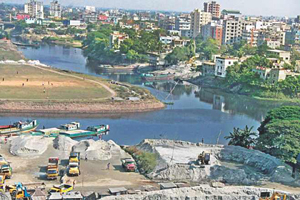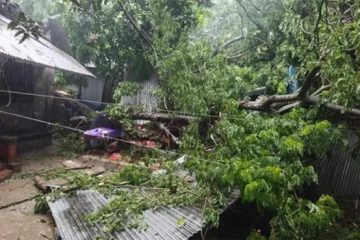Plans to cut dependency on groundwater from 78pc to 30pc in seven years
 With groundwater depleting fast in the capital, Dhaka Wasa is going to set up three more water treatment plants to increase the use of surface water significantly in the next seven years.
With groundwater depleting fast in the capital, Dhaka Wasa is going to set up three more water treatment plants to increase the use of surface water significantly in the next seven years.
The plants will be installed at Gandhabpur of Rupganj, Jasaldi in Mawa and Sayedabad in the capital at an estimated cost of around $1.5 billion, a top Wasa official told The Daily Star on condition of anonymity.
Water has to be piped to the plants from the Padma and the Jamuna rivers about 22 to 33 kilometres from the capital, as all four rivers — the Buriganga, Shitalakkhya,
Balu and Turag — around the city are heavily polluted.
It would have been possible to cut down the project costs by at least 15 percent if water of the four rivers could be used for these plants, said the official.
Construction of Jasaldi water treatment plant is likely to begin in April, and Gandhabpur plant in September this year, and Sayedabad phase-III plant in June next
year.
The Wasa now has five plants — two in Narayanganj and three in the capital — that treat surface water mainly from the Shitalakkhya.
Of the total demand of 225 crore litres of water a day, around 45 crore litres are supplied in Dhaka and Narayanganj cities from these plants while the rest is met
with groundwater.
Once the three new plants go into operation, the use of surface water would go up by almost 70 percent by 2021 as those will treat 140 crore litres of water a day,
said Taqsem A Khan, managing director of Dhaka Wasa.
Each year, groundwater level in the capital’s central area drops by 1 to 3 metres for excessive extraction of groundwater, said Taqsem.
According to statistics of Bangladesh Water Development Board, the groundwater level in Mirpur dropped 53.75 metres between 1991 and 2008, while the fall was 18.59
metres in Mohammadpur, 37.4 metres in Sabujbagh, 8.22 metres in Sutrapur, and 14.14 metres in Dhaka Cantonment area during the same period.
It means Dhaka is not only losing groundwater fast, but also subsiding gradually since the vacuum created by its extraction doesn’t get adequate recharge. As a result,
the city might face disastrous consequences in case of a major earthquake.
All four rivers around the capital are so polluted that the Wasa has no choice but to go for the rivers away from the capital, said Taqsem.
Of the four, water of the Shitalakkhya is already being used while that of the Buriganga is too polluted to be treated.
The Balu and Turag rivers are heavily polluted and have shrunk so much for rampant encroachments that their flow remains too low during the dry season.
JASALDI PLANT
Bangladesh and China have already inked a credit agreement of $290 million for the Jasaldi plant in Rupganj, said the Wasa MD.
Bangladesh government will fund the rest $100 million for the project.
Land acquisition for the project is underway and likely to be completed within six months, according to Taqsem.
GANDHABPUR PLANT
Negotiations are on to form a consortium of the Asian Development Bank, French Development Agency, European Investment Bank and Bangladesh government to finance the
$700 million project.
The Executive Committee of National Economic Council (Ecnec) has already approved the project. The Wasa has 73 acres of land at Gandhabpur for the plant and is
acquiring more for laying pipelines, said Taqsem.
SAYEDABAD PHASE III
Fifty percent of the project’s feasibility study, which began around eight months back, has already been completed and the rest is expected to be finished by March.
Once the study is completed, the Wasa will start looking for financiers for the $500 million project, according to Taqsem.
Danish International Development Agency (Danida) in 2012 had showed interest in providing $130 million for the project. And the French Development Agency has given
assurance that it will provide another $130 million, said the Wasa high-up.
Courtesy of The Daily Star




















